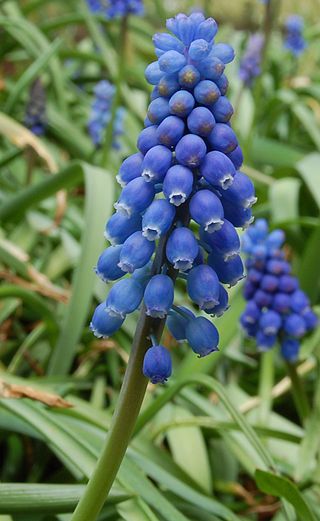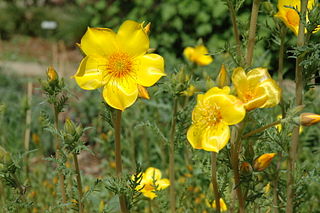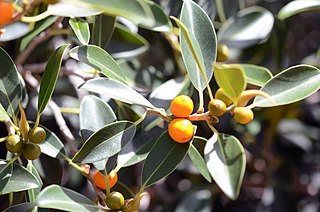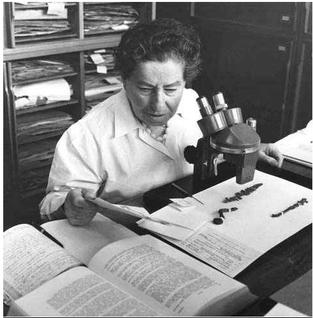
Chenopodium is a genus of numerous species of perennial or annual herbaceous flowering plants known as the goosefoots, which occur almost anywhere in the world. It is placed in the family Amaranthaceae in the APG II system; older classification systems, notably the widely used Cronquist system, separate it and its relatives as Chenopodiaceae, but this leaves the rest of the Amaranthaceae polyphyletic. However, among the Amaranthaceae, the genus Chenopodium is the namesake member of the subfamily Chenopodioideae.

Muscari is a genus of perennial bulbous plants native to Eurasia that produce spikes of dense, most commonly blue, urn-shaped flowers resembling bunches of grapes in the spring. The common name for the genus is grape hyacinth, but they should not be confused with hyacinths. A number of species of Muscari are used as ornamental garden plants.

Bellevalia is a genus of plants in the family Asparagaceae, subfamily Scilloideae. It was first described as a genus in 1808.
Michael Zohary was a pioneering Israeli botanist.

Mentzelia is a genus of about 60-70 species of flowering plants in the family Loasaceae, native to the Americas. The genus comprises annual, biennial, and perennial herbaceous plants and a few shrubs.
Agropyron desertorum is a plant species in the family Poaceae which was originally from Russian and Siberian steppes until it was introduced to the United States from there between 1907 and 1913. Prior to its introduction it was believed that Desert wheatgrass and crested wheatgrass are different species. Currently it can still be found in Central and Western United States, except for Idaho, Kansas, Louisiana, Minnesota, Oklahoma, and Washington.

Pierre Richer de Belleval, was a French botanist. He is considered the father of scientific botany. The standard author abbreviation Rich.Bell. is used to indicate this person as the author when citing a botanical name.

Alyssum desertorum is a species of flowering plant in the family Brassicaceae known by the common name desert madwort. It is native to Europe, North Africa and Asia, and it is found in parts of western North America as an introduced species and sometimes a weed. This is a hairy annual herb producing upright stems up to about 20 centimeters tall. The leaves are linear to oblanceolate-linear in shape, 0.5-4 millimeters long and 0.3-3 millimeters wide. The entire plant is covered by 8-20 rayed stellate trichomes, giving the plant a grayish appearance. It produces small yellowish flowers with petals that are 2-2.5 millimeters long and round, notched fruits 2.5-4.5 millimeters long. The brown seeds are winged, arranged two to a locule, and are about 1.5 millimeters long.

Artemisia spinescens is a North American species of sagebrush in the sunflower family, known by the common name budsage.

Brickellia desertorum is a species of flowering plant in the family Asteraceae known by the common names desert brickellbush and desert brickellia. It is native to Mexico, Central America, the West Indies, and the southwestern United States.

Alexander Eig was a botanist, one of the first plant researchers in Israel, head of the department of Botany at the Hebrew University in Jerusalem and co-founder of the National Botanic Garden of Israel on Mount Scopus campus.

Ficus brachypoda is a tree in the family Moraceae native to northern Australia. It is a banyan of the genus Ficus which contains around 750 species worldwide in warm climates, including the edible fig.
Bellevalia paradoxa is a bulb forming plant in the genus Bellevalia of the family Asparagaceae, formerly classified in the genus Muscari, under which name it is commonly sold as Muscari paradoxum.

Allium desertorum is a species of onion found in Israel, Jordan, Palestine, and Egypt. It is a small bulb-forming perennial; flowers are white with purple midveins along the tepals.

Naomi Feinbrun-Dothan was a Russian-born Israeli botanist, who became part of the academic staff at the Hebrew University of Jerusalem. She studied the flora of Israel and published dozens of articles and several analytical flora books. Just after her 91st birthday, she received the 1991 Israel Prize for her unique contribution to the Land of Israel studies.
Aspergillus desertorum is a species of fungus in the genus Aspergillus which has been isolated from desert soil. It is from the Nidulantes section. Aspergillus desertorum produces desertorin A, desertorin B, desertorin C, paxiline and emindol DA.

Chenopodium desertorum, common name frosted goosefruit, is a species of flowering plant in the family Amaranthaceae, indigenous to Australia where it is found in all mainland states.
Taraxacum desertorum is a species of flowering plant in the family Asteraceae. It is called the desert dandelion. This species can be found in Azerbaijan and throughout the Caucasus.
Craniospermum is a genus of flowering plants in the family Boraginaceae, native to Kazakhstan, the Altai, Siberia, Mongolia, and Xinjiang and Inner Mongolia in China. They are tuft-forming biennial or perennial herbs, and are generally highly endemic, thought to be relicts of the hypothesized ancient Mediterranean flora.
Eremothera is a genus of flowering plants in the family Onagraceae containing 7-12 species, native to Western North America.













